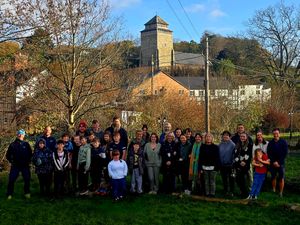Project to re-introduce pine martens to Mid Wales countryside.
Once a familiar sight, pine martens are to be re-introduced to the Mid Wales countryside.
Pine martens are so rare in Mid Wales that conservationists are unable to give population estimates.
But a new project aims to re-introduce them by capturing breeding couples in Scotland and releasing them on protected sites in our region.
The Vincent Wildlife Trust in the process of finding areas where they have the best chance of survival.
They will then bring mating couples south and allow nature to take its course.
If you go down to the woods today you will not see a wolf. You might see a big cat, but that's taking things off at a tangent.
The losses have piled up in modern times.
You could have heard a nightingale in Shropshire relatively recently. Not now.
Red squirrels have disappeared.
Water voles are hanging on, just about.
That is the bad news, but there is also some good news.
Some wildlife, like otters, are making it back all on their own, albeit helped by improved river quality. Others are getting a helping hand, like red kites, which have been reintroduced near Oxford.
What humans can take away, sometimes they can put back, and now there are plans to reintroduce the pine marten to the Mid Wales countryside, and across the border into Shropshire.
There are things to be said for pine martens. They are predators of those non-native creatures, the grey squirrel. And they look cute.
The £1.2 million pine marten recovery project plans to move the first 20 to Mid Wales this autumn, the trust said, with a further 20 possibly being brought in next year.
Reasons for their decline include the loss of habitat, fur hunting and a cull by gamekeepers in the early 1990s.
There have been sightings of pine martens in Mid Wales in recent years and in 2012 a carcass was discovered.
But experts believe they are on the verge of extinction from our region and this new project will be a start in establishing a thriving population once again.
The work will start first in Mid Wales, but will move across the border into Shropshire in time.
Experts hope the pine martens will eventually become a relatively familiar sight for people in our region.
Lizze Croose, conservation officer for the trust, said: "In Scotland, pine martens are a real tourist draw.
"Their reintroduction to Wales could be a big opportunity for wildlife tourism comparable to the success of the red kite.
"If successful, the recovery project will be rolled out to parts of England."
A live pine marten has not been photographed in Wales in decades.
Lizze said there were very few "unequivocal records" of sightings, although there are a number of unsubstantiated claims made each year.
Back in 2012, a pine marten was found dead on a road in Aberhafesp, near Newtown.
It was the first known retrieved carcass in the country for around 50 years.
The trust is looking for sites with few roads, no commercial shooting and a low fox population.
Foxes and golden eagles are the mammal's only known UK predators.
Pine martens need a woodland habitat as they nest in trees and den in tree cavities.
They also need an abundance of small mammals and fruit to eat.
The mammals mate in July and August and give birth the following March or April.
Their young, called kits, stay with the mother until they become independent in August.
They can have between one and five kits in a litter and males have no role in rearing the young and typically mate with several females.
The most recent estimates suggest there could be as many as 4,000 pine martens in Scotland.
A study in 2012 found that martens have spread from their Highland stronghold, north into Sutherland and Caithness and south-eastwards from the Great Glen into Moray, Aberdeenshire, Perthshire, Tayside and Stirlingshire, with some in the Central Belt, on the Kintyre and Cowal peninsulas and on Skye and Mull.
The pine marten can live to 18 years in captivity.
But in the wild, when open to disease and predators, a lifespan of eight to 10 years is more typical.




